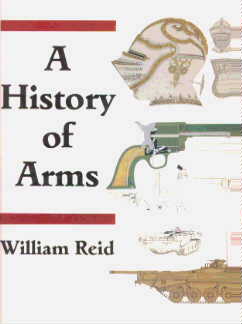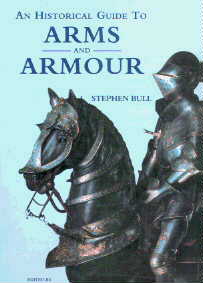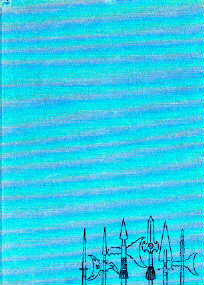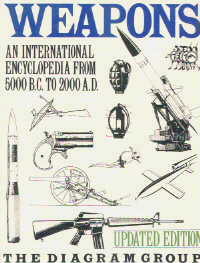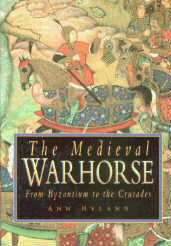Antique Weapons and Armour |
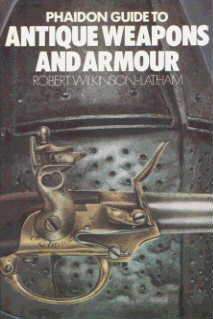
Phaidon Guide To
Antique Weapons and Armour
By Robert Wilkinson-Latham
PHAIDON PRESS, LTD. - Oxford (UK)
Copyright ©1981 by Elsevier Oxford Ltd.
ISBN: 0-7148-2173-X
Printed in the Spain
Antique Weapons and Armour
(from the dust-jacket end-flaps)
This guide to the personal armour and weapons of Europe, since post-classical times, and of the United States provides both a history and an aid to identification.
The book is divided into sections on armour, staff weapons, blades, bows, and firearms. All the main types, and some unusual and specialised ones, have been selected for illustration. Within each broad grouping the subject is treated in some detail. Thus the section on Blade Weapons is divided into swords, daggers and knives, and bayonets. Swords are discussed in pages devoted to mediaeval weapons, rapiers, court and hunting swords, basket hilts, 17th-century military, 18th-century infantry, light cavalry, heavy cavalry, and later cavalry swords, and swords of other corps, fine or presentation military swords, naval, and unusual swords.
The decorative, as well as the military, aspect of arms and armour is of special interest to collector and historian alike. The specially commissioned full-colour artwork attempts to do justice to the high level of craftsmanship and design. While iron, steel, brass and wood are the predominant materials, the use of enamel, ivory and precious materials is also represented.
A brief Introduction gives an account of earlier weapons, of the close relationship between developments in arms and armour, and the wider impact of these upon military tactics, the history of art and industrial techniques. Each section is prefaced by drawings which explain technical terms, and at the end of the book there is a list of the most important collections open to the public, a bibliography and an index.
Hard-back book measures roughly ~6-1/4" by ~9" (portrait); ~3/4" thick; 256 pages with over 600 items illustrated in full-colour artwork, photographs and line drawings.
Phaidon guide to antique weapons and...
Return to top of page.
The ARCHAEOLOGY of WEAPONS |
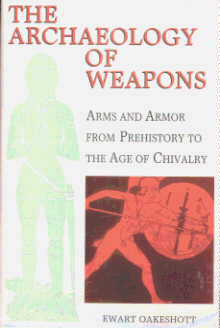
THE ARCHAEOLOGY OF WEAPONS
ARMS AND ARMOR FROM PREHISTORY TO THE AGE OF CHIVALRY
By Ewart Oakeshott
BARNES AND NOBLE BOOKS - New York - 1994
Copyright ©1960 by R. Ewart Oakeshott.
ISBN: 1-56619-596-9
Printed in the United States of America
THE ARCHAEOLOGY OF WEAPONS
(from the dust-jacket end-flaps)
In The Archaeology of Weapons, Ewart Oakeshott, an authority on medieval arms in Europe, presents a full, accurate, and readable account of the development and use of arms from the Bronze Age to the Age of Chivalry. His argument is based upon evidence of arms found in excavations, tombs, rivers and the ground, as well as in contemporary art. To this evidence, he adds descriptions from the literature of the times, giving life to the archaeological material and clarifying many of the issues which archaeology alone cannot explain. The text is illustrated with more than 170 drawings and 39 plates, 17 of which have been added for this edition. The book also includes a new preface by the author.
Oakeshott's aim is to show the development of arms in an unbroken sequence, and to present the archaeological material in its proper place within the framework of history. The Archaeology of Weapons is divided into four sections. The first covers the Bronze and Iron Ages, and the second the great folk migrations and the breakup of the Roman Empire. From this period, crucial to the development of the art of war, comes the most interesting material, the great burial of arms left by the Celtic and Teutonic peoples of northwestern Europe. These finds are discussed in detail alongside the historical background, and the one lends life and meaning to the other.
The third section covers the age of the Vikings, and includes much vivid literary material. The fourth section, dealing with the Age of Chivalry, is the real core of the book; following a general survey of the institution of chivalry itself, an understanding of which is vital to the correct appreciation of all the arms of the High Middle Ages, is a classification of medieval sword types from about A.D. 1050 to A.D. 1500. The human aspect of the sword is treated as an essential part of this lucid study and adds much to its archaeological interest.
From the evidence of his material, from the conclusions of many archaeologists and historians, and from his own detailed research, the author presents this definitive study of the weapons of thirty centuries.
Ewart Oakeshott is one of the world's leading authorities on the arms and armour of medieval Europe. His other works on the subject include Records of the Medieval Sword and The Sword in the Age of Chivalry, both standard works of reference in the field.
Hard-back book measures roughly ~6-3/8" by ~9-1/4" (portrait); ~1-1/4" thick; 359 pages.

The Archaeology of Weapons: Arms and Armor from Prehistory to the Age of Chivalry
Return to top of page.
ARMOR: From Ancient to Modern Times |

ARMOR
FROM ANCIENT TO MODERN TIMES
By Peter Klucina
Illustrated by Pavol Pevny
BARNES AND NOBLE BOOKS - New York
Original edition copyright ©1992 by Slovart Publishing Ltd.
English translation copyright ©1997 by Slovart Publishing Ltd.
ISBN: 0-7607-0475-9
Printed in Slovakia
ARMOR: From Ancient to Modern Times
(from the dust-jacket end-flaps)
Surviving pieces of armor are among the greatest treasures preserved from the past. protective armor of various types was worn by warriors of many centuries. Soldiers of the ancient city-states wore simple helmets and breastplates and carried shields. By the end of the Middle Ages, mounted warriors had come to be entirely encased in armor of very sophisticated construction, The armor that has survived to the present is not only interesting for the skill and artistry with which it was made, but reveals a great deal about the methods of warfare and even the social structure of past eras.
The author and illustrator have drawn upon the world's most renowned collections, both privately held and in museums, to tell the complete story of the development of defensive armor. The armor of each historical period is carefully described, with considerable attention to how the armor evolved and its practical function in the battlefield tactics of the time. A detailed account is given of how European armor was influenced by, and in turn influenced, armor from the Middle East and Asia.
The suits and individual pieces of armor described here are all magnificently illustrated, making clear many of the finer points of this equipage of a bygone era. Ironically, the most ornate armor was produced in the early gunpowder era, when armor ceased being essential on the battlefield and was mainly seen at tournaments and ceremonial processions. The lavish detail of such armor is shown to great effect here, with many stunning examples from around the world.
Hard-back book measures roughly ~9-1/2" by ~12-1/4" (portrait); ~1/2" thick; 133 pages.

Armor: From Ancient to Modern Times
Return to top of page.
Arms and Armor in the Art Institute of Chicago |
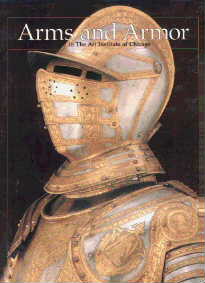
ARMS AND ARMOR
IN THE ART INSTITUTE OF CHICAGO
By Walter J. Karcheski, Jr.
A BULLFINCH PRESS BOOK - LITTLE, BROWN AND COMPANY
Copyright 1995 by The Art Institute of Chicago
ISBN: 0-8212-2205-8
Printed in Hong Kong.
ARMS AND ARMOR
(from the dust-jacket end-flaps)
The Art Institute of Chicago's George E. Harding Collection of arms and armor is one of the most popular exhibits in the museum, as well as one of the greatest collections of arms and armor in North America. Now, for the first time, these renowned treasures are presented in this handsome volume celebrating the richness of a lost art.
This book is a visual delight, with numerous examples of full and half armors, finely etched helmets, firearms with carved ivory stocks, back- and breastplates with gilded figures, and other exotic items all reproduced in full color. Additionally, paintings by such artists as Rembrandt and Ingres, along with drawings, woodcuts, and engravings, accompany these beautiful images to illustrate the many uses of arms and armor in medieval, Renaissance, and Baroque Europe.
Written by arms and armor specialist Walter J. Karcheski, Jr., the text delves into a world where feudalism and the institution of knighthood prevailed and where arms and armor played a crucial role. Karcheski traces the development and craftmanship of these magnificent suits and weapons throughout the centuries and discusses the armor developed for use in battle as well as that made specifically for tournaments, hunting, and pageantry. Additionally, he explores the craftsmen's guilds and the production and decoration of armor.
This stunning book, complete with a glossary of terms, is not only an elegant anthology but also a basic reference book that will delight and inform readers of all ages.
Hard-back book measures roughly ~9-1/4" by ~11-3/4" (portrait); ~3/4" thick; 128 pages; ~103 color & 12 black-and-white illustrations.

Arms and Armor in the Art Institute of Chicago, Vol. 1
Return to top of page.
Arms and Armour |
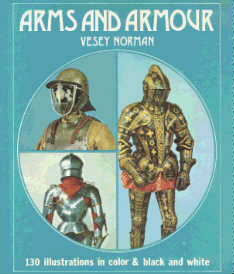
ARMS & ARMOUR
By Vesey Norman
OCTOPUS BOOKS - London
Copyright 1964 by George Weidenfeld and Nicolson Ltd.
This edition first published in 1972 by Octopus Books Ltd.
ISBN: 7064-0034-8
Printed in Hong Kong
ARMS & ARMOUR
(from the dust-jacket end-flaps)
Armour was the military answer to arms - until the invention of gunpowder
and hand firearms made it ineffective as a form of personal protection in
battle. But armour had met and survived many previous improvements in the
design of weapons, and the story of its gradual evolution in response to
constant challenge is the story of this book.
Between the simple mail shirt, or hauberk, of the early Middle Ages, and
the elaborately decorated armour of the fifteenth and sixteenth centuries,
extends a tradition of inventiveness and skill that has few parallels in
the other useful arts of the age. In combination with the illustrations,
Mr. Norman's scholarly text explains how arms and armour were made, the
tournaments and melees which were dress-rehearsals for war itself, the
decoration of armour by etching and heraldry, and the reasons for its final
decline except as a sentimental adjunct to a warrior's formal portrait.
Hard-back book measures roughly ~8-1/4" by ~9-3/4" (portrait); ~5/8" thick; 96 pages; 130 black and white and full-color illustrations.
Arms and Armour
Return to top of page.
Arms and Armour |
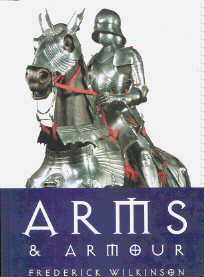
ARMS & ARMOUR
By Frederick Wilkinson
CHANCELLOR PRESS - London
Copyright 1978 by Reed International Books
First Published in 1978 by Hamlyn
This Edition Published in 1996 by Chancellor Press
ISBN: 1-85152-957-8
Printed in China
ARMS & ARMOUR
(from the dust-jacket end-flaps)
The history of arms and armour is one of two competing technologies: each improvement in the weapons of attack has been met with a strengthening of the means of defence.
This book traces the development of weapons from the earliest stone hand-axes to the sophisticated automatic weapons of today. It also tells the story of armour, which began as a simple wooden shield covered with animal skin, reached its zenith with the fifteenth-century knight who was totally encased in steel, was gradually rendered obsolete when firearms replaced the sword, and finally made a comeback in the First World War to protect the soldier against the horrors of the trenches. Due attention is given to weapons and armour of the Third World, which have in the past so often been neglected in studies of this kind. Often beautiful objects in their own right, they have, like their western counter-parts, been replaced by the products of sophisticated industrial technology which has imposed a world-wide cultural uniformity.
This book is illustrated with 80 full-colour and black and white illustrations.
Hard-back book measures roughly ~8-3/4" by ~11-3/4" (portrait); ~5/8" thick; 156 pages; 80 black and white and full-color illustrations.
Arms and Armour
Return to top of page.
Arms & Armor of the Medieval Knight |
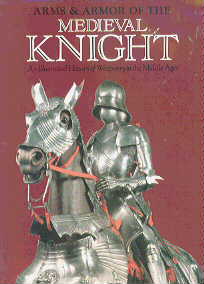
ARMS & ARMOR OF THE
MEDIEVAL KNIGHT
AN ILLUSTRATED HISTORY OF WEAPONRY
IN THE MIDDLE AGES
By David Edge & John Miles Paddock
CRESCENT BOOKS - New York
Copyright by Saturn Books Ltd.
1996 Edition
ISBN: 0-517-64468-1
Printed in China
ARMS & ARMOR OF THE MEDIEVAL KNIGHT
(from the dust-jacket end-flaps)
The knight in armor jousting for his lady's favor is one of the best known
figures in literature and romance. Arms & Armor of the Medieval Knight
is a brilliant, highly illustrated survey of the real story of knights and
their weapons and the often far from chivalrous wars and battle they fought.
For generations the devastating charging power of mounted knights dominated
the military affairs of Europe but throughout the medieval period weapons
and armor were evolving constantly, and a variety of styles developed.
This story is traced from the early days of chain mail and crude helmets to
the vastly expensive and beautifully elaborate suits of full plate armor of
the fifteenth and sixteenth centuries.
Arms & Armor of the Medieval Knight follows all these themes and also
looks at the history of knights in action, in war and in the hazardous melees
which tournaments often were in life if not in literature. A comprehensive
glossary of terms is provided, and an appendix gives details of the construction
of armor. The development of arms and armor is stunningly illustrated, with
many previously unpublished photographs and specially commissioned artwork
included. This book will be a delightful addition to any bookshelf.
Hard-back book measures roughly ~9-3/8" by ~12-1/4" (portrait); ~3/4" thick; 192 pages; 170 black and white and 150 color illustrations.
Return to top of page.
European & American Arms |
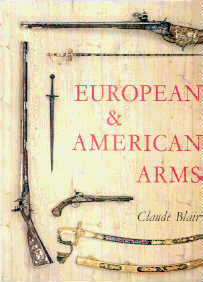
EUROPEAN & AMERICAN ARMS
By Claude Blair
BOANAZA BOOKS - New York
Copyright 1962 by Claude Blair.
Manufactured in the United Sates of America
EUROPEAN & AMERICAN ARMS
(from the dust-jacket end-flaps)
EUROPEAN AND AMERICAN ARMS is the most complete visual encyclopaedia of its subject to have been published in a single volume. For the collector, dealer or museum curator in need of a representative corpus of illustrations of the weapons used in the western world from about 1100 to 1850, the book will be indispensable. There are over 600 photographs of pieces from nearly all the major collections of Europe, America and Russia. There is also a comprehensive series of detailed drawings, specially made for the book, of regulation swords and firearms, accessories, marks, etc.
As an indication of the book's scope mention may be made of some of its subdivisions: Swords and Daggers (including Sheaths, Hangers and Sheath-knives); Staff Weapons; the Sling and the Bow; Projectile Weapons; Firearms and other Gulls (Systems of Ignition, the Pistol, Repeating Firearms, Spring and Air-Guns, Accessories); Decoration. Each section is accompanied by a long text describing historical and technical development, while the highly factual captions to the plates themselves will be found invaluable to the museum-curator, collector or dealer anxious to date, compare or authenticate a piece in his collection. Additional information for which too little space is available in the captions is given in the Notes on the Illustrations.
It is sometimes said of books on Arms that they have merely been compiled from previously existing works. No such criticism could be made of European and American Arms. Claude Blair (about whom further information will be found on the back flap of this jacket) has had unequalled opportunities at the Tower of London and the Victoria and Albert Museum of personally handling the weapons about which he writes, and in consequence he has produced a work of reference written emphatically from first-hand sources.
Hard-back book measures roughly ~9" by ~12" (portrait); ~1" thick; 134 pages; numerous illustrations and black-and-white photos; no tears or folds; binding fully intact; very-light shelf-scuffing and wear. Book and dust-jacket are in otherwise very-good to fine condition.
!SOLD OUT!
Return to top of page.
Arms and Armor of the Samurai |

ARMS AND ARMOR OF THE
SAMURAI
THE HISTORY OF WEAPONRY IN ANCIENT JAPAN
By I. Bottomley and A.P. Hopson
CRESCENT BOOKS - New York
Copyright 1988 by Brompton Books Corp.
This Edition Published in 1995 by Crescent Books
ISBN: 0-517-10318-4
Printed in China
ARMS AND ARMOR OF THE SAMURAI
(from the dust-jacket end-flaps)
The Samurai conjures up romantic visions of the chivalrous knight of Ancient Japan, willing to uphold his honor in lone combat or sacrifice his life in massive mounted charges, always following the code of Bushido (the Way of the Warrior).
A member of the aristocracy, from the tenth century the Samurai was primarily a mounted archer. This is reflected in the light, lamellar yoroi armor which left the right arm free for drawing his bow. Helmets were simple, with leather neckpieces. Battle began with an exchange of arrows, and was followed by a series of hand-to-hand combats among champions, who relied on the sword.
The long wars of Kusunoki and Ashikaga produced several changes in the nature of warfare. Fighting in wooded, mountainous countryside, hand-to-hand combat came into its own. The bulky yoroi was superceded by the lighter, less constricting do maru and the no dachi, a longer version of the naginata (glaive), was introduced. The renowned Samurai cult of the sword began in this period. The Samurai's most ornate and elaborate armor dates from the Tokugawa era, and was probably not intended for use in actual battle.
The long development of arms and armor in the Samurai's 700-year history is fully detailed in this handsome volume. Illustrated with over 300 photographs, Arms and Armor of the Samurai will be a welcome addition to the libraries of all military enthusiasts.
Hard-back book measures roughly ~9-1/4" by ~12-3/8" (portrait); ~3/4" thick; 192 pages; ~300 photos.

Arms and Armor of the Samurai
Return to top of page.
Japanese Arms & Armor |
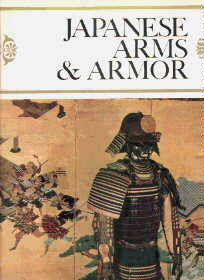
JAPANESE ARMS & ARMOR
Introduction by H. Russell Robinson, F.S.A.
CROWN PUBLISHERS INC. - New York
Copyright 1969 by Arms and Armour Press, H. Russell Robinson,
and Bramante Editrice.
Library of Congress Catalog Card Number: 79-79521
Printed in England and Italy; bound in Scotland
JAPANESE ARMS & ARMOUR
(from the dust-jacket end-flaps)
This is a splendidly produced and lavishly illustrated volume.
Never before have so many color and black-and-white photographs,
together with drawings and reproductions of old woodcuts, been presented
in a work printed in English on Japanese arms and armor.
Over the centuries, the warriors of old Japan and their armorers devoted
great skill and care to the style and quality of their military accouterments.
This is more than evident when one studies the details illustrated in this
work and sees such examples as the remarkable chiseling confined to the
narrow panels on the deadly sword blades or the minute ornamentation on
sword guards and mounts, all of which are well represented in this volume
with its superb large-scale illustrations. Of particular interest in this
work are the great variety of shapes of helmets: these are fine examples of
the degree of intricate detail in which the Japanese craftsman worked, and
here his creative skill is shown at its best. With conventional helmets
built up of narrow plates and the more ornate styles, where the shape of
an animal's head or some vegetable or exotic fruit is chosen, it is easy to
forget that these beautiful creations are firstly functional - to be worn
while defending life and limb.
The majority of pieces illustrated belong to the Edo period, from 1614 to
1867, which is of particular interest to all students of the art and history of Japan.
The many pages of photographs were specially printed for this volume in Italy.
There are wonderful collections of Japanese art treasures in the Museo Stibbert in
Florence and in the Museo Orientale in Venice. The introductory text is by
H. Russell Robinson, F.S.A., of the Tower of London, author of several standard
works on Japanese arms and armor. Mr. Robinson has enhanced his introduction
to the plates with his own fine drawings.
Hard-back book measures roughly ~9-7/8" by ~12-3/8" (portrait); ~3/4" thick;
numerous black and white and full-color illustrations; no tears or folds; binding fully intact; moderate shelf-scuffing and wear, mainly to dust-jacket. Book and dust-jacket are in otherwise good condition.
!SOLD OUT!
Return to top of page.
JAPANESE ARMOR: The Galeno Collection |
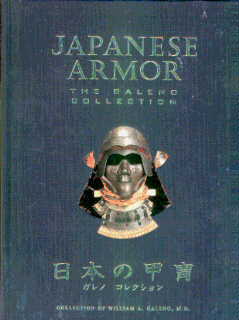
JAPANESE ARMOR
THE GALENO COLLECTION
The Collection of William A. Galeno, M.D., Text by Ian Bottomley
STONE BRIDGE PRESS - Berkeley, California
Text copyright ©1998 by Ian Bottomley; photographs copyright © by Kazuhiro Tsuarat
ISBN: 1-880656-36-1
Printed in Hong Kong.
JAPANESE ARMS & ARMOUR
(from an editorial review at AMAZON Books)
Richly illustrated, this new book presents Japanese armor from the collection of William A. Galeno, M.D., one of the largest private collections of Japanese armor in the West. It includes more than 100 pieces of armor, helmets, masks and accoutrements - almost all of which are made available to the public for the first time - spanning from the 14th century of the Muromachi period to the 19th century of the Edo period. With catalog entries and essays on the history of Japanese armor by Ian Bottomley, Curator of Oriental Arms and Armour at Her Majesty's Royal Armoury, Leeds, England, this catalog is a valuable reference for scholars, collectors and readers interested in the subject.
Hard-back book measures roughly ~11-1/4" by ~8-3/4" (portrait); ~3/4" thick; 211 pages, virtually all exquisitely illustrated in color. New books.
Available only from AMAZON.com .
Return to top of page.
Russian Arms and Armour |
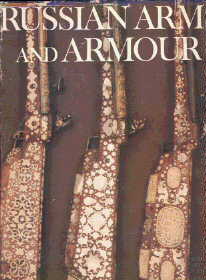
RUSSIAN ARMS and ARMOUR
Edited by Yuri Miller
AURORA ART PUBLISHERS - Leningrad
Copyright 1982 by Aurora Art Publishers.
Printed and bound in Finland
RUSSIAN ARMS and ARMOUR
(from the dust-jacket end-flaps)
This volume contains reproductions of Russian arms and armour from the outstanding collection of the Armoury in the Moscow Kremlin, which includes almost all the most perfect works created by the talented Russian armourers and gunsmiths over the course of several centuries. Pieces of weaponry from the Armoury form the basis of this volume, but they are supplemented by works from the collection of the Historical Museum, encompassing a period from the 16th to the middle of the 20th century and notable for its systematic character and completeness.
The Armoury was already used as a storehouse for weapons and especially valuable objects as early as the end of the 15th or the beginning of the 16th century. In the course of the 16th and 17th centuries it became a major centre for the manufacture of all sorts of arms and armour.
A finnly rooted, genuine national school of the art of arms production with its own principles and traditions developed in the Armoury. Here such skilled Russian armourers and gunmakers as Konon Mikhailov, Dmitry Konovalov, Nikita Davydov, Grigory Viatkin, Ilya Prosvit, Vasily Titov, and Pervusha Isayev worked, creating arms and arnlour which were true artistic masterpieces.
The Armoury Museum established in 1806 is one of the oldest in Russia. From 1851, the Ammoury was housed in a new building constructed specially for the museum on the territory of the Kremlin.
The Armoury collection is mainly formed of weapons produced by its craftsmen in the 16th and 17th centuries, as well as arms and amrour manufactured at Tula, Zlatoust, and St. Petersburg.
The Armoury collections were repeatedly enlarged. In 1810 more than 3,000 pieces of arms and armour were added from the Rustkammer, one of the first Russian museums in Oranienbaum (now Lomonosov) near St. Petersburg. In the 19th century, arms and armour preserved in the Trinity-St. Sergius Monastery near Moscow and the St. Petersburg Diamond Workshops were moved to the Armoury.
At the present time, the Armoury houses and exhibits more than 7,000 pieces which are fully representative of the whole range of Russian fine arms and armour.
Hard-back book measures roughly ~9-3/8" by ~12-1/2" (portrait); ~3/4" thick; 208 pages with 164 illustrations, 133 in colour; no tears or folds; binding fully intact; moderate shelf-scuffing and wear, mainly to dust-jacket.
Book and dust-jacket are in otherwise good to very-good condition.
!SOLD OUT!
Return to top of page.
Imperial Austria - Treasures of Art, Arms, and Armor from the State of Styria |
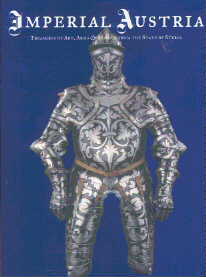
IMPERIAL AUSTRIA
TREASURES OF ART, ARMS, & ARMOUR
FROM THE STATE OF STYRIA
By Peter Krenn and Walter J. Karcheski, Jr.
ART EXHIBITIONS AUSTRALIA LIMITED - Australia
Copyright ©1992 by the Museum of Fine Arts,
Houston and Prestal Verlag, Munich.
Australian edition Copyright ©1998 by the State of Styria
and Dr. Annelie Hochkofler.
ISBN: 1-875460-11-X
Printed in Australia
IMPERIAL AUSTRIA
(from the Director's Foreward)
This is a great reference work about arms and armor from Imperial Austria (Styria), based upon items exhibited in Australia. Do not be confused by the two names (Austria and Australia); this book is about Austrian (Styrian) Arms and Armour, not Australian. - C. Alan Russell, Arms to Armor (arms2armor.com)
Imperial Austria: Treasures of Art, Arms and Armour from the State of Styria is an exhibition unlike any other seen in Australia. Comprising a rare and spectacular collection of Renaissance and Baroque art, arms and armour, it provides a graphic insight into a dramatic phase in Austria's cultural, artistic and technological history. The exhibition covers a critical era in the history of the Austrian State of Styria - a strategically important region in southeast Austria famous not only for its natural beauty but also for its mineral wealth and for the production of iron and steel - through works which are as compelling in their artistic beauty as they are fearsome in their original intent.
In preparing for this major exhibition the Government of Austria and the State of Styria have been exceedingly generous in facilitating the loan of immensely valuable exhibits from the collection of 16th and 17th century arms and armour housed at the Landeszeughaus Graz, the famous and miraculously intact Renaissance armoury in the city of Graz, the capital of Styria. As a border state, Styria played a crucial role in the defence of territories that formerly were governed by the Holy Roman Emperors. It was these territories that were the target of successive waves of invasion from the east by Ottoman armies loyal to the cause of Islam.
Imperial Austria: Treasures of Art, Arms and Armour from the State of Styria offers works of consummate craftsmanship - almost three hundred in number - that are presented in a context embracing artistic, historical and social considerations. Given the charter of each of the Australian institutions participating in the exhibition tour, it is fitting that this sense of context is created with the inclusion in the exhibition of paintings and sculpture from the period, as well as works on paper and decorative arts, antique maps and early printed books. On the basis of a sequence of formal portraits, early technical manuals, images of pageants and actual battles, and other supporting material of a similar kind, the powerful iconography associated with arms and armour is here compellingly revealed.
This exhibition surveys one of the noblest arts practised by German-speaking master-craftsmen of the Renaissance period. It includes sophisticated and elaborate examples of arms and armour which collectively represent an artistic and technological high point in metal work of the period. Armour has long been admired for its essentially sculptural qualities and its symbolism was well understood by generations of portrait painters. Indeed, for centuries, artists frequently depicted their sitters clad in armour as a means of emphasising power and social station or to suggest valour of attitude, or else to convey a general sense of moral gravitas.
No collection of this kind - even of a modest nature - exists in Australia. Imperial Austria represents therefore a unique opportunity for Australian audiences to see at first hand a comprehensive exhibition of the noble art of the armourer. Happily the period surveyed by this collection also represents a high water mark in the history of the art of armour.
That such a fine and important collection has been made available for touring in Australia at this time, we owe our heartfelt thanks to DDr Schachner-Blazizek, Deputy Governor of the State of Styria and Cultural Minister and to Dr Annelie Hochkofler, Special Envoy for the State of Styria, whose enthusiastic commitment over many months to the success of this venture earns our most sincere gratitude. Throughout the entire period of planning for this tour, Dr Hochkofler has collaborated with each of the three Australian gallery venues - the National Gallery of Victoria, the Powerhouse Museum and the Art Gallery of Western Australia - and on behalf of each institution we acknowledge her special role in the enterprise while at each institution we register our gratitude to our colleagues, Dr Robert Edwards and Ms Carol Henry at Art Exhibitions Australia. Once again it has been a great pleasure to work with them both and we record our sincere thanks to them for the leading role they have taken in the implementation and management of the Australian tour of Imperial Austria.
Paper-back (wraps); book measures roughly ~8-1/2" by ~11" (portrait); ~1/2" thick; 133 pages - filled with colour plates of arms and armour.
Imperial Austria Treasures of Art Arms
Return to top of page.
Dictionary of Weapons and Military Terms |
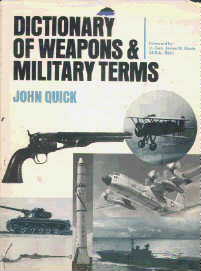
DICTIONARY of WEAPONS and MILITARY TERMS
By John Quick, Ph.D.
McGRAW-HILL BOOK COMPANY - New York * St. Louis
Copyright ©1973 by McGraw-Hill, Inc.
Printed in the United States of America
DICTIONARY
(from the dust-jacket end-flaps)
As ultimate arbiters of power, accompaniments to age-old rituals of courage and loyalty, or embodiments of developing technology, weapons and weapons systems have always exercised a unique fascination over men's minds. The implements of war have left their mark on human culture and are as much a part of human history as the tools of agriculture and industry.
This dictionary provides a comprehensive record of the significant weapons developed over the centuries by armies all over the world. It is a singular reference that will be welcomed by students, professional military men, hobbyists, and connoisseurs alike for its breadth of coverage, conciseness, and authoritative definitions.
Whatever your level of interest, you will be fascinated by the definitions and details in such areas as...
